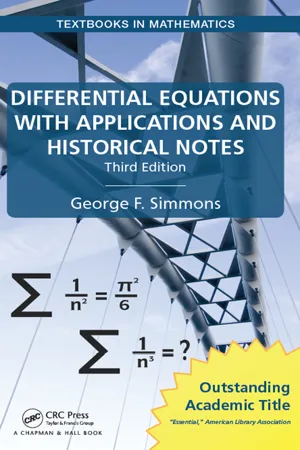
Differential Equations with Applications and Historical Notes
George F. Simmons
- 764 páginas
- English
- ePUB (apto para móviles)
- Disponible en iOS y Android
Differential Equations with Applications and Historical Notes
George F. Simmons
Información del libro
Fads are as common in mathematics as in any other human activity, and it is always difficult to separate the enduring from the ephemeral in the achievements of one's own time. An unfortunate effect of the predominance of fads is that if a student doesn't learn about such worthwhile topics as the wave equation, Gauss's hypergeometric function, the gamma function, and the basic problems of the calculus of variations—among others—as an undergraduate, then he/she is unlikely to do so later.
The natural place for an informal acquaintance with such ideas is a leisurely introductory course on differential equations. Specially designed for just such a course, Differential Equations with Applications and Historical Notes takes great pleasure in the journey into the world of differential equations and their wide range of applications. The author—a highly respected educator—advocates a careful approach, using explicit explanation to ensure students fully comprehend the subject matter.
With an emphasis on modeling and applications, the long-awaited Third Edition of this classic textbook presents a substantial new section on Gauss's bell curve and improves coverage of Fourier analysis, numerical methods, and linear algebra. Relating the development of mathematics to human activity—i.e., identifying why and how mathematics is used—the text includes a wealth of unique examples and exercises, as well as the author's distinctive historical notes, throughout.
-
- Provides an ideal text for a one- or two-semester introductory course on differential equations
-
- Emphasizes modeling and applications
-
- Presents a substantial new section on Gauss's bell curve
-
- Improves coverage of Fourier analysis, numerical methods, and linear algebra
-
- Relates the development of mathematics to human activity—i.e., identifying why and how mathematics is used
-
- Includes a wealth of unique examples and exercises, as well as the author's distinctive historical notes, throughout
-
- Uses explicit explanation to ensure students fully comprehend the subject matter
Outstanding Academic Title of the Year, Choice magazine, American Library Association.
Preguntas frecuentes
Información
Chapter 1
The Nature of Differential Equations. Separable Equations
1 Introduction
(1) |
(2) |
(3) |
(4) |
(5) |
(6) |
(7) |
(8) |
(9) |